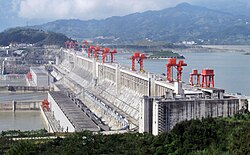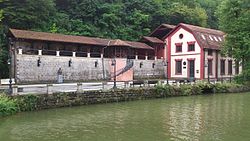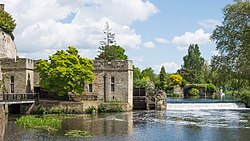Hydroelectricity

Hydroelectricity is electricity made by generators that are turned by the movement of water. It is usually made with dams that partly block a river to make a reservoir of water. Water is released, and the pressure of the dam (potential energy stored in the dam) forces the water down pipes that lead to a turbine. This causes the turbine to turn, to turn a generator which makes electricity.
This renewable energy method makes about one sixth of the world's electricity. It produces less pollution than the fires of steam engines do. Some places such as Norway and Quebec get most of their electricity this way.
Because all methods have advantages and disadvantages, most countries have several ways to generate electricity. For example, hydroelectric methods have certain advantages, and atomic energy has quite different advantage.For most countries today, hydroelectric energy is the preferred, or one of the preferred methods. Mainly because it is a renewable energy which means that you can reuse it and it will never run out.
Hydroelectric power plants
| Rank | Station | Country | Location | Capacity (MW) |
|---|---|---|---|---|
| 1 | Three Gorges | 30°49′15″N 111°00′08″E / 30.82083°N 111.00222°E | 22,500 | |
| 2 | Itaipu | 25°24′31″S 54°35′21″W / 25.40861°S 54.58917°W | 14000 | |
| 3 | Xiluodu (in construction) | 28°15′52″N 103°38′47″E / 28.26444°N 103.64639°E | 10,780 | |
| 4 | Guri | 07°45′59″N 62°59′57″W / 7.76639°N 62.99917°W | 10,235 | |
| 5 | Tucuruí | 03°49′53″S 49°38′36″W / 3.83139°S 49.64333°W | 8,370 | |
| 6 | Grand Coulee | 47°57′23″N 118°58′56″W / 47.95639°N 118.98222°W | 6,809 |
Advantages
The way the electricity is produced does not harm the environment as much as fossil fuels like oil or coal do. Hydroelectricity is very powerful and safe, and produces no waste.
An important advantage of hydroelectric dams is their ability to be used as a peaking power plant. When the electricity demand declines, the dam simply stores more water. Water that has been stored in a reservoir can be released (let go) when needed, so the energy can be made quickly. Some hydroelectricity generators use pumped storage to store excess energy (often during the night), by using the electricity to pump water up into a basin. Electricity can be generated when demand increases. This flexibility also makes hydroelectricity a good match for less controllable intermittent energy sources. When the wind is not blowing or the sun is not shining, hydroelectricity can be created.
Using stored water in river dams is sometimes complicated by irrigation needs which may happen out of phase with peak electrical demands.
Another advantage is that hydroelectricity cannot run out as long as there is a good water supply. Once the dam is built, the electricity costs very little, no waste or pollution is produced, and electricity can be generated whenever it is needed.
A few hydro turbines do not have a dam but instead use the current of the "run of the river". They produce less electricity and cannot store energy for later use.
Disadvantages
The building of large dams to hold water can damage the environment. In 1983, the Australian government stopped the Tasmanian state government from building a dam on the Gordon River in Tasmania after a huge public protest.[2] The dam would have flooded the Franklin River. The Three Gorges Dam in China is the world's largest hydroelectricity project, and the world's largest power plant of any kind. The dam has flooded a huge area, meaning that 1.2 million people had to be moved. Scientists are concerned about many problems with the dam, such as pollution, silt, and the danger of the dam wall breaking.[3]Also it doesn’t provide many jobs for people, is expensive to run and set up and is a real danger to marine life.
Hydroelectricity Media
The Three Gorges Dam in Central China is the world's largest power-producing facility of any kind.
The Warwick Castle water-powered generator house, used for the generation of electricity for the castle from 1894 until 1940
A micro-hydro facility in Vietnam
Pico hydroelectricity in Mondulkiri, Cambodia
Measurement of the tailrace and forebay rates at the Limestone Generating Station in Manitoba, Canada
The Ffestiniog Power Station can generate 360 MW of electricity within 60 seconds of the demand arising.
The Hoover Dam in the United States is a large conventional dammed-hydro facility, with an installed capacity of 2,080 MW.
References
- ↑ Earth Science. Holt, Rinehart and Winston. 2001. p. 211. ISBN 0-03-055667-8.
- ↑ "History of the Franklin River Campaign 1976-83 — The Wilderness Society". www.wilderness.org.au. Retrieved 2009-07-02.
- ↑ "Three Gorges Dam | International Rivers". internationalrivers.org. Archived from the original on 2009-04-29. Retrieved 2009-07-02.
Other websites
- The Climate Change Guide easy-to-understand information on hydroelectricity








